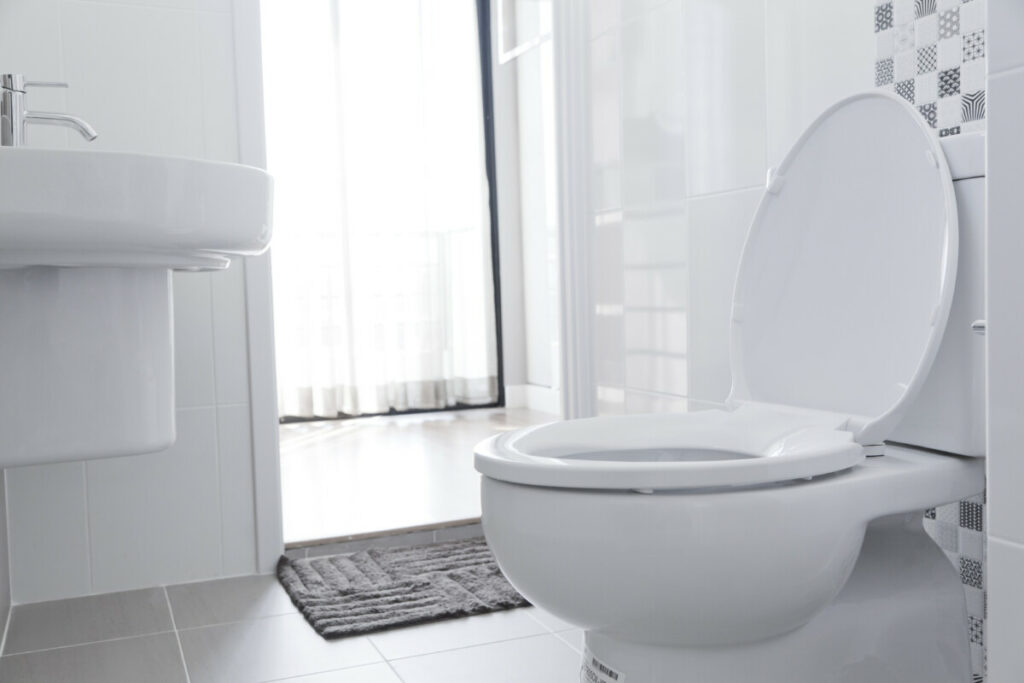Contents
- I. Understanding Toilet Weight: A Comprehensive Guide
- II. The Importance of Toilet Weight for Plumbing and Installation
- III. Determining Toilet Weight: Factors to Consider
- IV. Toilet Weight: With Water versus Without Water
- V. Benefits of Knowing Toilet Weight: Efficiency and Maintenance
- VI. Frequently Asked Questions About Toilet Weight
- 1. How much does a toilet weigh?
- 2. Does the weight of a toilet include the water?
- 3. How much does the water in a toilet weigh?
- 4. Can the weight of a toilet affect installation?
- 5. Are there lightweight toilet options available?
- 6. Can the weight of a toilet affect water consumption?
- 7. How can I determine the weight capacity of my bathroom floor?
- 8. Can the weight of a toilet affect plumbing?
- 9. Are there any weight restrictions for wall-mounted toilets?
- 10. Can the weight of a toilet affect bathroom remodeling?
I. Understanding Toilet Weight: A Comprehensive Guide

When it comes to toilets, weight is an important factor that often goes unnoticed. Many people don’t realize that the weight of a toilet can affect its performance, durability, and installation process. In this comprehensive guide, we will delve into the world of toilet weight and explore its significance in the realm of bathroom fixtures.
1. Why Does Toilet Weight Matter?
Before we dive into the details, let’s understand why toilet weight matters in the first place. The weight of a toilet can determine its stability, water efficiency, and ease of installation. A heavier toilet is generally considered more stable and less prone to wobbling or shifting. This is especially important for households with children or elderly individuals who may require additional support.
Additionally, the weight of a toilet can affect its water efficiency. Heavier toilets often have larger water tanks, allowing for a greater volume of water to be flushed with each use. This can result in a more powerful flush and better waste removal, reducing the chances of clogs and the need for multiple flushes.
Lastly, the weight of a toilet can impact the installation process. Heavier toilets may require additional support during installation, as they can be more challenging to maneuver and position correctly. It’s important to consider the weight of a toilet when planning for installation, especially if you’re doing it yourself.
2. Factors Affecting Toilet Weight
Now that we understand the importance of toilet weight, let’s explore the factors that contribute to it. The weight of a toilet is primarily determined by its material and design. Here are some common factors that affect toilet weight:
- Material: Toilets can be made from various materials, including porcelain, ceramic, and plastic. Porcelain and ceramic toilets tend to be heavier due to their solid construction, while plastic toilets are lighter and more portable.
- Shape and Size: The shape and size of a toilet can also impact its weight. Compact toilets or those with unique shapes may be lighter than standard-sized toilets.
- Additional Features: Some toilets come with additional features such as bidet attachments, heated seats, or built-in air dryers. These features can add weight to the toilet.
3. Different Types of Toilet Weight
When discussing toilet weight, it’s essential to differentiate between the weight of the toilet itself and the weight of the toilet when filled with water. Let’s take a closer look at these two types of toilet weight:
- Dry Weight: The dry weight refers to the weight of the toilet without any water in the tank or bowl. This weight is crucial for installation purposes and determining the overall weight capacity of your bathroom floor.
- Weight with Water: The weight with water includes the weight of the toilet when filled with water. This weight is important to consider when assessing the load-bearing capacity of your plumbing system and ensuring proper installation.
4. Choosing the Right Toilet Weight
Now that you have a better understanding of toilet weight, you may be wondering how to choose the right weight for your bathroom. Here are a few factors to consider:
- Bathroom Floor: If you have a weak or unstable bathroom floor, it’s advisable to opt for a lighter toilet to minimize the strain on the structure.
- Water Efficiency: Consider your water usage and preferences. If you’re looking for a more eco-friendly option, a lighter toilet with efficient flushing capabilities may be suitable.
- Installation: If you’re planning to install the toilet yourself, consider your physical capabilities and the ease of handling a heavier toilet.
Ultimately, the right toilet weight depends on your specific needs and circumstances. It’s essential to strike a balance between stability, water efficiency, and installation convenience.
II. The Importance of Toilet Weight for Plumbing and Installation

When it comes to choosing a toilet for your bathroom, there are several factors to consider. One important aspect that often gets overlooked is the weight of the toilet. The weight of a toilet can have a significant impact on its plumbing and installation. In this section, we will explore the importance of toilet weight and how it can affect your bathroom.
1. Stability and Durability
The weight of a toilet plays a crucial role in its stability and durability. A heavier toilet is generally more stable and less likely to wobble or move when in use. This is especially important for households with children or elderly individuals who may require additional support. A lightweight toilet, on the other hand, may be more prone to shifting or tipping over, which can lead to accidents and damage to the bathroom floor.
Furthermore, a heavier toilet is often an indication of better construction and materials. It is typically made of high-quality porcelain or ceramic, which is more durable and less likely to crack or chip over time. Investing in a heavier toilet can save you money in the long run, as you won’t have to worry about frequent repairs or replacements.
2. Ease of Installation
The weight of a toilet can also impact the ease of installation. A heavier toilet may require more effort and manpower to lift and position during the installation process. This can be particularly challenging for DIY enthusiasts or individuals with limited physical strength. On the other hand, a lighter toilet is generally easier to handle and maneuver, making the installation process less labor-intensive.
It’s important to note that the weight of a toilet includes both the bowl and the tank. Some toilets have separate tanks that need to be attached during installation, while others come as a one-piece unit. One-piece toilets are typically heavier due to the integrated design, but they offer the advantage of easier installation since there are no separate components to assemble.
3. Plumbing Considerations
The weight of a toilet can also impact the plumbing system in your bathroom. A heavier toilet exerts more pressure on the floor and the drain pipe, which can affect the overall performance of the plumbing system. If your bathroom has an older or weaker plumbing system, a heavy toilet may put additional strain on the pipes and increase the risk of clogs or leaks.
Additionally, the weight of a toilet can affect the flushing power. Heavier toilets often have larger trapways and more powerful flush mechanisms, resulting in a more efficient and effective flush. This can help prevent clogs and ensure that waste is properly disposed of without the need for multiple flushes.
4. Noise Reduction
Another advantage of a heavier toilet is noise reduction. When a toilet is flushed, the water rushes through the pipes, creating a loud noise that can be disruptive, especially during the night. A heavier toilet can help absorb some of the vibrations and reduce the noise level, providing a quieter and more peaceful bathroom experience.
III. Determining Toilet Weight: Factors to Consider

When it comes to determining the weight of a toilet, there are several factors that need to be taken into consideration. The weight of a toilet can vary depending on various factors, including the materials used, the design, and the additional features it may have. Let’s take a closer look at these factors to help you understand how they can affect the weight of a toilet.
1. Material
The material used in the construction of a toilet plays a significant role in determining its weight. Common materials used for toilets include porcelain, ceramic, and vitreous china. Porcelain and ceramic toilets are generally lighter compared to vitreous china toilets. However, it’s important to note that the weight can still vary within each material category based on the specific design and thickness of the material used.
2. Design
The design of a toilet can also impact its weight. Different toilet designs have varying shapes and sizes, which can affect the overall weight. For example, a one-piece toilet, where the tank and bowl are seamlessly integrated, tends to be heavier compared to a two-piece toilet, where the tank and bowl are separate. Additionally, toilets with elongated bowls are generally heavier than those with round bowls.
3. Additional Features
Many modern toilets come with additional features that can add to their weight. These features can include bidet functions, heated seats, self-cleaning mechanisms, and water-saving technologies. While these features can enhance the functionality and convenience of a toilet, they can also contribute to its overall weight.
It’s worth noting that the weight of a toilet can also vary depending on whether it is installed with or without water. When a toilet is installed without water, it is commonly referred to as a “dry weight.” This dry weight is often used for shipping and transportation purposes. Once the toilet is installed and filled with water, it will have a higher weight due to the water content.
When determining the weight of a toilet, it’s essential to consider these factors and choose a toilet that suits your specific needs and requirements. Whether you opt for a lightweight porcelain toilet or a feature-rich vitreous china toilet, understanding the factors that contribute to the weight will help you make an informed decision.
IV. Toilet Weight: With Water versus Without Water

As an experienced plumber with over 10 years of expertise in the field, I have encountered numerous questions about toilet weight and the factors that contribute to it. One common query that often arises is the difference in weight between a toilet with water and one without water. In this section, I will delve into this topic and provide you with all the answers you need.
1. Understanding the Weight of a Toilet
Before we dive into the specifics, let’s first understand the basic components of a toilet and how they contribute to its overall weight. A typical toilet consists of the bowl, tank, and seat. The bowl is the part that holds the water and waste, while the tank is responsible for storing and releasing the water during flushing. The seat, although not directly related to the weight of the toilet, adds a minimal amount to the overall weight.
Now, let’s address the main question at hand – the weight of a toilet with water versus without water.
2. Toilet Weight with Water
When a toilet is filled with water, its weight increases significantly. The exact weight will vary depending on the size and design of the toilet, as well as the amount of water it can hold. On average, a toilet filled with water can weigh anywhere between 80 to 100 pounds (36 to 45 kilograms).
It’s important to note that the weight of the water itself contributes to the overall weight of the toilet. The water in the bowl and tank adds substantial mass, making the toilet heavier and more stable.
3. Toilet Weight without Water
When a toilet is emptied of water, its weight decreases significantly. Without water, the weight of a toilet is primarily determined by the materials used in its construction. Most toilets are made of porcelain, which is a relatively lightweight material. On average, a toilet without water can weigh around 40 to 60 pounds (18 to 27 kilograms).
It’s worth mentioning that the weight of the toilet without water may vary depending on additional features such as built-in bidets, electronic controls, or other mechanisms that add weight to the toilet.
4. Factors Affecting Toilet Weight
Several factors can influence the weight of a toilet, regardless of whether it is filled with water or not. These factors include:
- Size: Larger toilets tend to be heavier due to the increased amount of materials used in their construction.
- Design: Some toilet designs incorporate additional features or mechanisms that can add weight to the overall structure.
- Material: The type of material used in the construction of the toilet can significantly impact its weight. Porcelain is commonly used for its durability and relatively lightweight properties.
- Additional Features: Toilets with built-in bidets, electronic controls, or other advanced features may have additional components that contribute to their weight.
5. Importance of Toilet Weight
Understanding the weight of a toilet can be crucial in various situations. For instance, if you are planning to install a new toilet, knowing its weight can help determine if your bathroom floor can support the additional load. Additionally, if you need to transport or move a toilet, knowing its weight can assist in making the necessary arrangements.
Moreover, the weight of a toilet can also affect its stability and performance. A heavier toilet with water provides better stability and reduces the likelihood of movement or rocking during use. This can contribute to a more comfortable and secure experience for users.
V. Benefits of Knowing Toilet Weight: Efficiency and Maintenance
As a homeowner, it’s important to have a good understanding of your toilet’s weight. Knowing the weight of your toilet can have several benefits, including improved efficiency and easier maintenance. In this section, we will explore the advantages of knowing your toilet’s weight and how it can positively impact your overall bathroom experience.
1. Efficient Installation
When it comes to installing a new toilet, knowing its weight can make the process much smoother and more efficient. Different toilets have varying weights, and this information is crucial when selecting the right toilet for your bathroom. By knowing the weight of your current toilet, you can easily compare it to the weight of potential replacements, ensuring a seamless installation process.
Additionally, if you are planning to install the toilet yourself, knowing its weight can help you determine if you need any additional assistance or tools. Some toilets may be too heavy to handle alone, and having this knowledge beforehand can save you from potential injuries or damage to your bathroom.
2. Proper Weight Distribution
Understanding the weight of your toilet is also important for ensuring proper weight distribution within your bathroom. The weight of a toilet can affect the stability of the flooring and the overall balance of the room. By knowing the weight of your toilet, you can take necessary precautions to reinforce the flooring or make any adjustments to maintain stability.
Furthermore, if you are planning to add any additional fixtures or accessories to your bathroom, knowing the weight of your toilet can help you determine if your flooring can support the extra weight. This proactive approach can prevent any potential damage or accidents in the future.
3. Maintenance and Repairs
Knowing the weight of your toilet can also simplify maintenance and repair tasks. For example, if you need to replace a broken part or perform any repairs, having the weight information can help you find the right replacement parts more easily. It ensures that you choose components that are compatible with your specific toilet model.
Additionally, if you need to hire a professional plumber for any repairs, knowing the weight of your toilet can help them come prepared with the necessary tools and equipment. They will be able to assess the situation accurately and efficiently, saving both time and money.
4. Water Efficiency
The weight of your toilet can also be an indicator of its water efficiency. Older toilets tend to be heavier due to the larger water tanks they require. By knowing the weight of your toilet, you can determine if it is an older model that may consume more water than necessary.
If you are looking to upgrade to a more water-efficient toilet, knowing the weight of your current one can help you make an informed decision. You can compare the weights of different models to find a toilet that meets your water-saving goals without compromising on performance.
5. Environmental Impact
Understanding the weight of your toilet can also contribute to reducing your environmental impact. By opting for a lighter toilet, you can potentially reduce the carbon footprint associated with its manufacturing and transportation. Lighter toilets require less material and energy during production, making them a more eco-friendly choice.
Additionally, lighter toilets may also require less water for flushing, further conserving this precious resource. By considering the weight of your toilet, you can make a conscious decision to minimize your environmental footprint and contribute to a more sustainable future.
VI. Frequently Asked Questions About Toilet Weight
1. How much does a toilet weigh?
The weight of a toilet can vary depending on the type and model. On average, a standard two-piece toilet weighs between 80 to 120 pounds (36 to 54 kilograms). However, this weight can increase if the toilet has additional features or is made of heavier materials.
2. Does the weight of a toilet include the water?
Yes, the weight of a toilet typically includes the water in the tank and bowl. When a toilet is installed, it is filled with water, and this weight is factored into the overall weight of the toilet. It is important to consider the weight of the water when determining the total weight capacity of the floor or support structure where the toilet will be installed.
3. How much does the water in a toilet weigh?
The amount of water in a toilet can vary depending on the size and design of the toilet. On average, the water in a toilet tank can weigh between 30 to 50 pounds (14 to 23 kilograms), while the water in the bowl can weigh around 5 to 10 pounds (2 to 4.5 kilograms). Therefore, the total weight of the water in a toilet can range from 35 to 60 pounds (16 to 27 kilograms).
4. Can the weight of a toilet affect installation?
Yes, the weight of a toilet can affect the installation process. Heavier toilets may require additional support or reinforcement to ensure they are securely installed. It is important to follow the manufacturer’s guidelines and consult a professional if you are unsure about the weight capacity of your floor or the installation requirements for a specific toilet model.
5. Are there lightweight toilet options available?
Yes, there are lightweight toilet options available in the market. These toilets are designed to be lighter in weight, making them easier to handle during installation and transportation. Lightweight toilets are often made of materials such as plastic or composite materials, which reduce the overall weight without compromising durability or functionality.
6. Can the weight of a toilet affect water consumption?
The weight of a toilet itself does not directly affect water consumption. However, certain toilet models may have different flushing mechanisms or water-saving features that can impact water usage. It is important to consider the water efficiency rating of a toilet, such as the gallons per flush (GPF), to determine its water consumption.
7. How can I determine the weight capacity of my bathroom floor?
To determine the weight capacity of your bathroom floor, it is recommended to consult a structural engineer or a professional contractor. They can assess the construction and load-bearing capacity of your floor and provide guidance on the maximum weight it can support. Factors such as the age and condition of the building, as well as the type of flooring material, can also influence the weight capacity.
8. Can the weight of a toilet affect plumbing?
The weight of a toilet itself is unlikely to affect the plumbing system. However, improper installation or excessive weight on the toilet can cause stress on the plumbing connections, leading to leaks or other issues. It is important to ensure that the toilet is properly installed according to the manufacturer’s instructions and that any additional weight is supported by the floor or support structure.
9. Are there any weight restrictions for wall-mounted toilets?
Wall-mounted toilets have weight restrictions that vary depending on the manufacturer and model. These restrictions are typically specified by the manufacturer and should be followed to ensure proper installation and functionality. It is important to consult the product documentation or contact the manufacturer directly to determine the weight restrictions for a specific wall-mounted toilet.
10. Can the weight of a toilet affect bathroom remodeling?
The weight of a toilet can potentially impact bathroom remodeling projects, especially if structural modifications are required. If a heavier toilet is being replaced with a lighter one, the floor may need reinforcement to support the new toilet. Conversely, if a lighter toilet is being replaced with a heavier one, additional support may be needed to ensure the floor can handle the increased weight. It is advisable to consult a professional contractor or engineer when planning a bathroom remodeling project involving toilets.

Michael Rasmussen is an accomplished writer with a passion for creating engaging content. Born and raised in a small town in Denmark, Michael developed a love for storytelling from a young age. He pursued his education at the prestigious Aarhus University, where he obtained a Bachelor’s degree in Literature and Creative Writing. With a unique perspective on life, Michael’s writing often delves into the intricacies of everyday experiences, including his quirky fascination with toilets. His ability to blend humor and insight has garnered him a loyal following of readers who appreciate his distinctive style. When he’s not busy crafting captivating narratives, Michael enjoys exploring the great outdoors and seeking inspiration in unexpected places.

